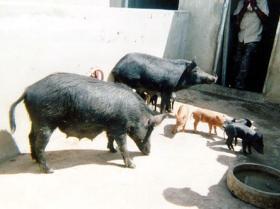Research: Processing cassava roots for pig feed

Scientists in Guadaloupe in the West Indies studied the effects of processing methods on the digestibility and palatability of cassava root in growing pigs.
Four experiments were carried out to evaluate the effects of processing methods on the digestibility and palatability of cassava roots (CR) in growing pigs.
Fresh CR were ground with a vegetable biomass chopper (ground CR) or manually chopped with a slicing tool into thin chips (chopped CR).
An electric grinder with a 3 mm diameter screen was used to make CR meal from dried ground CR obtained after a 6-h drying period (meal-6 h).
The ground, chopped and meal forms were chosen because they are the main forms used for feeding pigs in such geographical areas.
Experiment 1
In Experiment 1, changes in hydrocyanic acid (HCN) and dry matter (DM) contents in chopped and ground CR were measured during a 24-h drying period in a solar dryer.
The minimum drying times required to reach the minimum HCN content in ground and chopped CR were 3 and 6 h, respectively.
The second and third experiments were designed to determine the effects of the processing form (chopped, ground or meal forms; Experiment 2) and the effects of increasing incorporation rates of ground CR (Experiment 3) on the coefficient of total tract apparent digestibility (CTTAD) of nutrients and energy in the experimental diets.
Experiment 2 and 3
In Experiment 2, a total of six pigs were studied. Each pig was fed alternately with one of the three experimental cassava forms, being offered 400 g/kg DM of CR products and 600 g/kg DM of a control corn soya bean meal (CSBM) diet.
In Experiment 3, four pigs were studied and the dietary treatment included a gradual increase in ground CR from 0 to 600 g/kg of DM offered in the CSBM diet.
Results
In Experiment 2, it was found that the energy CTTAD of the experimental diet was not affected by the cassava form (chopped, ground or meal), and averaged 0.927.
In Experiment 3, the CTTAD of organic matter and energy linearly increased with the gradual incorporation of ground CR. The digestible and metabolizable energy values of the ground CR were 15.6 and 15.5 MJ/kg DM, respectively.
Experiment 4
Experiment 4 was designed to investigate dietary preferences between a CSBM diet and the CR offered in chopped, ground or meal forms with different drying durations (3 or 6 h).
Variations in the palatability of CR products were mainly related to differences in the DM and HCN contents.
Discussion
From the results obtained in Experiments 2–4, the ground CR dried for 6 h appeared to be the most appropriate form for incorporating cassava roots into pig feed under the conditions of a small-scale farming system.
The full article can be obtained from ScienceDirect











